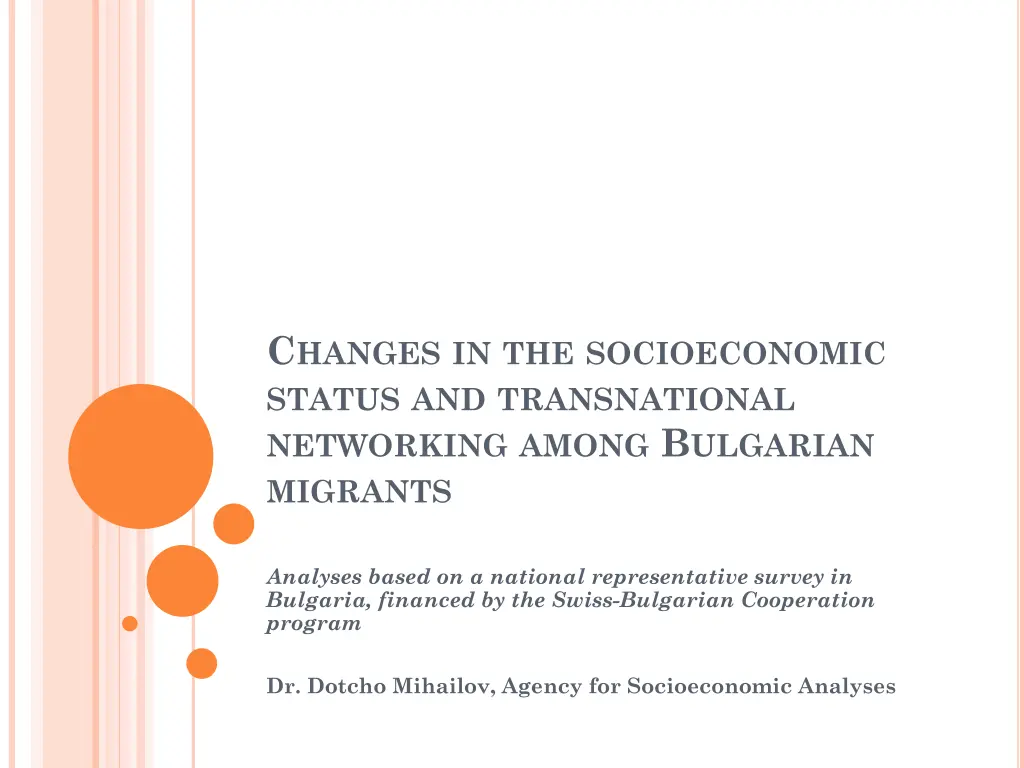
Socioeconomic Status and Transnational Networking Among Bulgarian Migrants
Explore the socioeconomic changes and transnational networking behaviors of Bulgarian migrants based on a national survey. Analyzing employment shifts, return migrants' occupations abroad, and professional shifts, this study sheds light on the impact of migration on the Bulgarian workforce. Learn about the distribution of migrants by planning regions, employment patterns abroad versus back home, and the shifts in professions before and after migration.
Download Presentation

Please find below an Image/Link to download the presentation.
The content on the website is provided AS IS for your information and personal use only. It may not be sold, licensed, or shared on other websites without obtaining consent from the author. If you encounter any issues during the download, it is possible that the publisher has removed the file from their server.
You are allowed to download the files provided on this website for personal or commercial use, subject to the condition that they are used lawfully. All files are the property of their respective owners.
The content on the website is provided AS IS for your information and personal use only. It may not be sold, licensed, or shared on other websites without obtaining consent from the author.
E N D
Presentation Transcript
CHANGES IN THE SOCIOECONOMIC STATUS AND TRANSNATIONAL NETWORKING AMONG BULGARIAN MIGRANTS Analyses based on a national representative survey in Bulgaria, financed by the Swiss-Bulgarian Cooperation program Dr. Dotcho Mihailov, Agency for Socioeconomic Analyses
METHODOLOGY National representative survey with a sample of 3907 people aged 15-65 Distribution by planning regions Northwest - 428, North central - 457, Northeast - 520, Southwest - 1157 (including Sofia), South central - 787, Southeast 558 Model: Two-stage probability cluster sample, stratified by place of residence with a Kish selection at the last step (nearest birthday method) Maximal margin of error at a 50% relative frequency: 1,57% nationally, about 3,8% regionally Data collection: Interviewers of the Agency for socioeconomic analyses through standardized questionnaire Data collection period: November 2013 Data control Data entry through a mask, ensuring minimum operator errors; Local and central 10% telephone direct check ups Sample peculiarities of the presented data: Return migrants data based on 15,5% (606 respondents) Potential migrants (24,9%) Preliminary data
EMPLOYMENT SHIFTS Economic activity abroad: Most of the migrants (74,5%) work; only 2,8% are unemployed 36.8% Unemployment back home is particularly typical for the unqualified labour force; freelancers and state officials recover better after going back home Before migration Abroad 19.6% Back home Migration decreases unemployment but returning home puts an even bigger burden on unemployment 2.8% Percent unemployed return migrants
RETURN MIGRANTS OCCUPATIONS ABROAD By qualification groups By economic activity agriculture - 21,1% 26.8% construction - 19,6% hotels and restaurants - 14,0% household/family activities - helper, caretaker, cook, garden - 13,1% 3.4% 3.3% 1.3% Elementary occupations Managers and team leaders Specialists Medical professionals
PROFESSIONAL SHIFTS By economic activities By qualification groups Agriculture Elementar y Specialists Construction Household activities 21.1% Education sector 26.7% 19.6% 18.6% 17.6% 19.3% 19.3% 13.1% 9.6% 8.7% 5.2% 3.9% 3.4% 2.9% 2.1% 2% 1.3% 0.7% Before Abroad Back home Before migration Abroad Back home
SHIFTS IN INCOMES Return migrants median income BGN The median income surges 4 times abroad cannot recover when coming back home Being abroad decreases income inequality and social contrasts The decile dispersion ratio is the lowest abroad No differences between Roma and Bulgarians when they are abroad: BGN 2000 versus BGN 500/300 2000 Total 1700 Sofia 1600 Village 700 630 500 400 400 300 Before Abroad Back home
INSURANCE STATUS Higfher social benefits back home Deteriorated access to services back home Social insurance deteriorates when going back home (58,8% abroad 54,4% back home) Deteriorated access to health services back home (rejected health services 3,1% abroad / 11,2% back home) Sustained low health insurance levels - 62,6% versus 69,6% back home, but still under the 84,5% nationally (age 15-65) Social benefits abroad 3,4% granted 2,1% rejected Social benefits back home - 40,3% (36% unemployed) Working migrants without contracts 46,1%
NETWORKING WHILE ARRIVING ABROAD Initial travel Finding a job How - mostly via group networking (48%) Bulgarian colleagues / acquaintances 34,7% people from the home town 13,3% Individual networking via close relatives (22,8%) Group networking via colleagues/friends and people from the home town, typical for lower social strata (24,3%) What jobs Via group networking low qualified jobs Via internet and agencies better off social groups; better jobs
NETWORKING WITH HOME AND LOCAL COMMUNITIES Networking with Bulgaria less dependent on travel: Skype (70,8%) - the most frequent channel of communication, typical for active social strata Travel (37,9%) - typical for lower social strata, indicating insecure jobs abroad Networking is focused on Bulgarians: Interactions with the local community is much lower than with the Bulgarians - 66,9% / 80,8% Addressing Bulgarians or locals in a problematic situation: 45,9% / 15,5% Interactions focused on interactions with Bulgarians - typical for lower social strata though the opposite is not verified for the richer Relative self-categorisations in lower social strata 80,8% - the Bulgarians are of the same social status as me 49,7% - I am of lower social status than the locals
SELF-IDENTITY SHIFTS AMONG RETURN AND POTENTIAL MIGRANTS About 1/3 (29,4%) of the Bulgarians at national have other than national Bulgarian identity Who are the that do not feel Bulgarian: 46,7% of the potential emigrants and 45,4% of the circular migrants feel either EU and World citizens young, educated and richer people, coming from bigger settlements Cultural self-identity 69.6% Total 48.1% 23.3% 15.9% 11.7% 8.0% 7.3% 6.2% 3.8% 2.4% 2.2% 1.0% 0.5%
SELF-IDENTITY SHIFTS, RESULTING FROM THE MIGRATION EXPERIENCE The multicultural (World) identity dramatically surges from 6,2% (national sample) to 15,9% (return migrants) Multicultural identity - based on active socio- economic and demographic profiles Lower dependency on ethnic identity: Turks are the strongest Europeans (25,5% EU identity), the Bulgarians are the biggest Wold citizens (17,8%) the Roma are the biggest Bulgarians (59,1%) bigger than the ethnic Bulgarian themselves (49,4%)
